Dassault Mirage IIIC
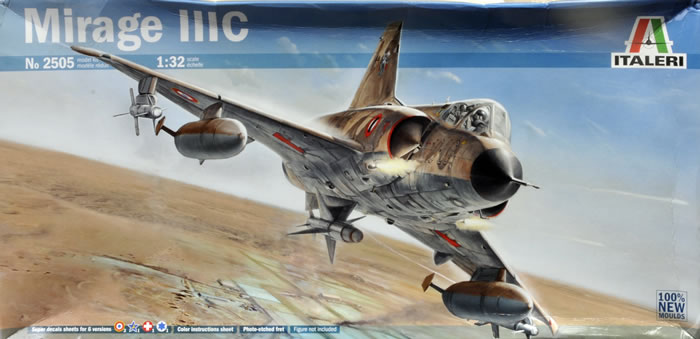
Italeri, 1/32 scale
| S u m m a r y : |
Catalogue Number: |
Italeri Kit No.2505 - Dassault Mirage IIIC |
Scale: |
1/32 |
Contents and Media: |
300+ injection medium grey coloured moulded parts; 13 clear injection moulded parts; 22 etched metal parts and markings for six aircraft. |
Price: |
£89.99 (£74.99 export price) plus shipping available online from Hannants' website
and specialist hobby retailers worldwide |
Review Type: |
First Look |
Advantages: |
Nicely moulded; easy assembly; etched metal details. |
Disadvantages: |
|
Conclusion: |
Recommended. |
Reviewed by
Mick Evans

Eduard's 1/48 scale Roland C.II Weekend Edition
is available online from Squadron.com for only $17.96!
This new release from Italeri has been out for a few months now but this is the first time that I have seen the kit up close and the first review of the kit for HyperScale.
When I first started to work on the RAAF Mirage IIIO aircraft I took to studying the Mirage in detail including the Mirage IIIC versions, while not an expert on the C I do understand many of the differences between versions.
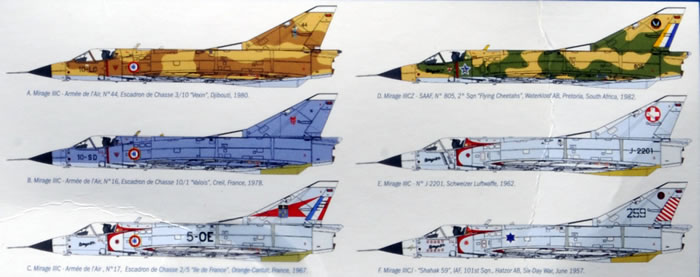
Before now, there has only been one release of the Mirage in 1/32 scale and that has been the now-dated Revell Mirage IIIE/V in its many guises. While this was a good basic kit for its time it lacked any real detail, in fact there is not much detail at all, but it can still be built into a nice kit with some work and after-market resin and metal parts.
Italeri's 1/32 scale Mirage IIIC comprises 300+ injection medium grey coloured moulded parts, 13 clear injection moulded parts, 22 etched metal parts and markings for six aircraft.
The detail is finely engraved and looks to be very accurate from my memory and the shape overall is also very accurate.
Looking at the new Italeri kit I was amazed at the level of detail included in the box. Wow is a word that comes quickly to mind. While there is a lot of Eduard etched metal available for this kit and I have all of these in hand to review soon, the kit does not really need them. You are removing great detail to replace it with slightly better detail. I have a very hard decision to make as to whether to use all of Eduard etched and resin sets that I have or just use some bits to enhance the current detail. The replacement resin wheels is an easy decision as are the nice Eduard colour etched ejection seat straps, but the wheel well detail, the kit detail is great and I may create a bigger issue by removing the moulded detail to replace with the slightly better etched metal. Also the etched metal hydraulic pies are flat whereas the kit detail is raised and round. A bit of pondering to do here I feel.
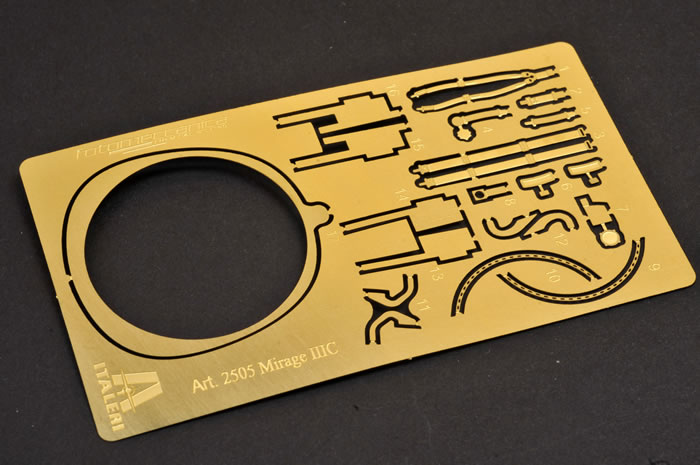
Construction starts with the Martin Baker Mk.4 ejection seat and usually the kit offerings are deficient in detail. This offering from Italeri is very good as ejection seats go, and includes some of the intricate detail on the sides of the top head box of the seat that are very prominent and visible as they are above the canopy sill. On the left side of the seat head box is the very prominent and important drogue gun while on the right hand side is the all-important Barometric Time Unit (BTRU) negating the purchase of a resin Martin Baker Mk.4 seat from an aftermarket source of which I think the only accurate one for a Mirage is available from Paul Fisher in his superb Mirage IIIE cockpit set.
The only item missing that I think the seat needs is the scissors mechanism located on top of the seat that operates below 10,000ft to allow the drogue chute to deploy the main chute. There is also a link cord from the top of the drogue gun that attaches to the top of the drogue chute which is easily made from wire.
The etched metal straps provided by Italeri are nice and accurate for the MB 4 seat having both the seat and parachute shoulder straps. Missing though are the parachute crotch straps and the all-important boyang leg straps. These are easily scratch built or you can just replace them with the Eduard etched set which contains all seat and parachute straps in the correct colours. Both Eduard and Italeri are inaccurate with their lap seat belts as they have the Quick Release Box (QRB) attached to the lap Belt. The QRB is actually attached to a very wide waist sash that also contains the manual parachute release handle, easy to scratch build. The remainder of the seat detail that is missing is difficult to see with seat installed in the cockpit tub so it will not be missed. The seat cushions themselves have some nice texture moulded into them so they are not just a flat featureless part.
The cockpit is the next assembly and is made up from 13 parts. The instrument panel and the side panels have really nice and accurate raised detail which can be painted easily and the dials extend themselves to easily have decals such as those produced by Airscale fitted. The prominent radar scope dominates the instrument panel with the large Position Homing Indicator (PHI) on the right hand panel and Bezu Ball attitude indicator on the left hand panel, at some point in time this moved to the centre panel above the radar scope which is depicted in the Eduard etched panel. Looking at the Eduard etched replacement panel I am faced with a hard decision. While the Eduard panel is beautifully colour etched including many placards, it is dead flat and does not contain the slanted radar panel. The side consoles are similar to the main panel very nice and accurate raised detail. Once again Eduard does replace these with dead flat etched panels that while nice the switches and knobs do not stand out.
Finally the rear bulkhead, this is one of the busiest areas in the Mirage cockpit and one that finally a manufacturer has almost got right with the Mirage in any scale. The rear bulkhead has all of the Cyrano radar electronics boxes fitted to it as well as the gunsight control box fitted mid-way down the bulkhead behind the ejection seat. While it is not 100% perfect it is packed with detail including the main electrical harnesses that terminate in bulkhead plugs.
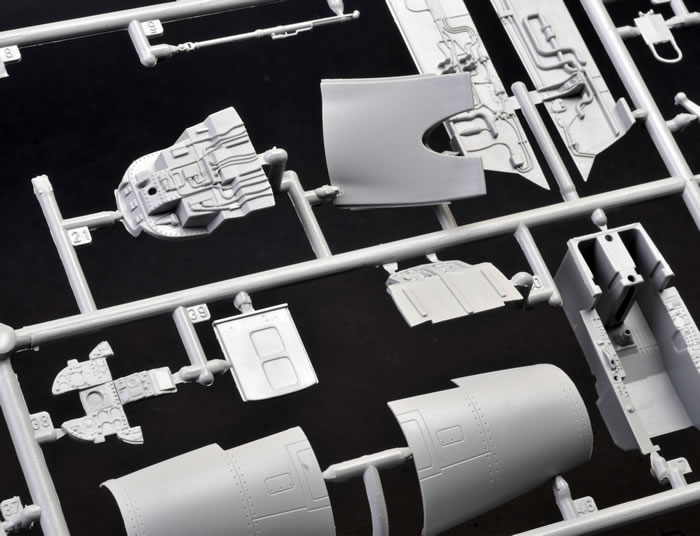
The final parts are the cockpit side walls which are very accurate and the very busy instrument panel shroud which contains the very accurate gunsight and the very messy cabling behind the instrument panel.
The canopy parts are nice and clear but my sample opening section is split down the middle due to rough handling during the long trip to Australia.
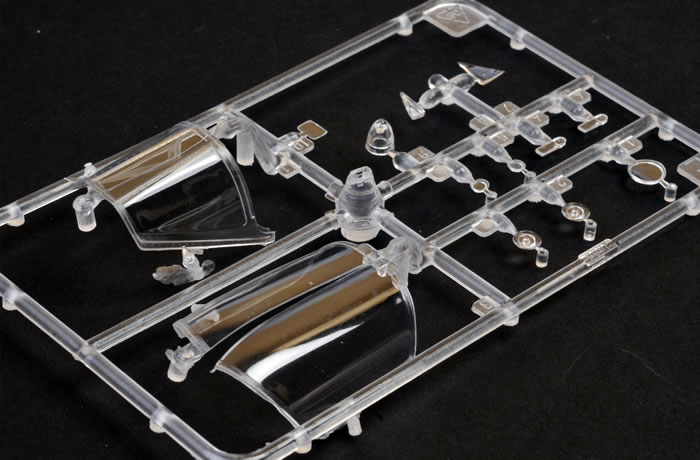
The Atar engine detail is beautiful and includes a full length afterburner that ends with the early Atar engine 09B eyelid aperture. The compressor face is nicely detailed including the air starter bullet. The afterburner inside detail is also nice with the liner detail clearly visible along with the turbine detail, rear bearing mount and afterburner flame holder. The engine is so nice that I am in a bit of turmoil as to whether to display it on the nicely detailed engine roll back stand included or to install it in the fuselage. It is one of the most comprehensively detailed kit engines that I have seen.
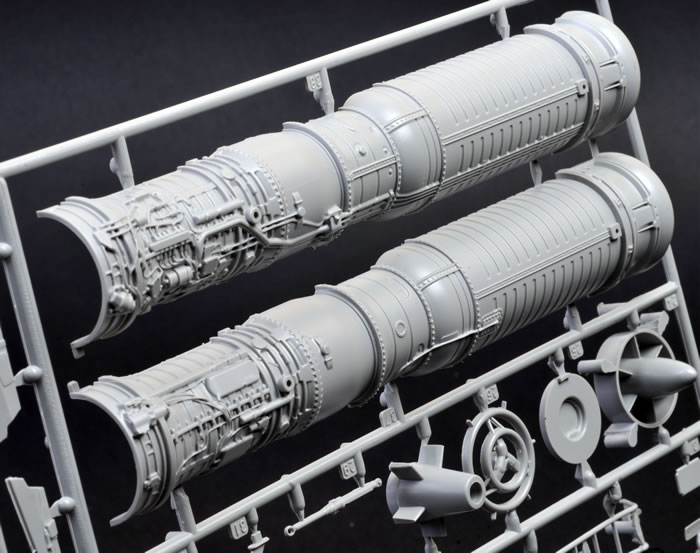
The main wheel wells are excellently detailed and comprise of five parts and likewise the nose wheel well is made up from five parts and is also nicely detailed.
The nose wheel well has all of the prominent air conditioner ducting and hydraulic piping required and also includes the water separator to the rear of the well. The main wells have almost everything in place including the engine “top hat” access panels and the prominent fuel tank bottom panels. All of the undercarriage doors have very accurate and prominent detail included.
The intakes have nice ducting that lead back as far as the eye could see on the real aircraft, this includes the duct spitter panel. You cannot see the engine compressor on the aircraft unless you almost put your head inside the intake.
A key inclusion in the kit is the separate elevons and pitch dampers as when the hydraulic system is not pressurised the elevons will droop to the full down position. The actuators are provided as two-part assembly allowing for the elevons to be positioned in the streamlined position (hydraulic power on) or in the drooped position (hydraulic power off and bled down).
The undercarriage legs and wheels have excellent detail with the wheels being the high pressure tyres rather than the low pressure tyres of the IIIE. Italeri has correctly supplied the flatter main wheel flipper doors rather than the bulged flipper doors introduced on the IIIE to cover the wider low pressure tyres. My only comment on the tyres is they look as though they are a bit too flat and bulged for the high pressure tyres. Two types of brake unit are supplied and both have superb detail. Having said this Eduard Brassin supply replacement wheels with even better detail and are not as flattened and bulged which represent the high pressure wheels better.
Separate speed brakes are included and I must say these are excellent and very accurate in detail and just beg to be displayed in the open position.
At this point I was struggling to find a negative comment for the kit that was not just plain nit picking for the sake of nit picking. Then it hit me, whilst almost every form of external stores is included the most obvious is not. The prominent 30mm Defa cannon barrels are not included in the kit. I had to double check but they are not included. They stick out about a third of the length of the gun trough, so these will need to be sourced from brass tube or similar.
A very nice and accurate boarding ladder is also included to allow the modeller to display the aircraft in a diorama setting.
The texture of the surface is not perfectly smooth and may not lend itself easily to Metalizer paints for the natural metal finishes. I would recommend polishing with steel wool for this type of finish but for a camouflage scheme this should not matter.
The only flaw with the moulding is there is a strange step on the upper fuselage where the fin fillet is installed. It appears like there was an inserted panel here and it has created a slight step. Quick test with a sanding stick shows it quickly disappears or you could scrape with a sharp knife.
Stores
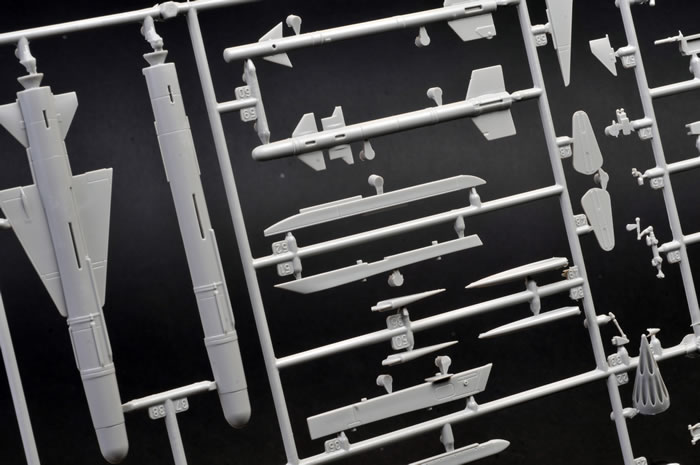
Finally turning to the external stores provided:
-
2 x AIM 9B Sidewinder air to air missiles – well detailed and very accurate including the launch rail
-
2 x Matra 530 air to air missiles, - well detailed and very accurate, you almost get two as this is a common sprue that you get two of, but you are short two main and two small fins which are easily scratch built if you need a second 530 for another project. The engraving on this missile is very accurate and finally and accurate centreline launch rail for the 530 missile.
-
2 x Matra 550 Magic air to air missiles – while these are highly accurate and have the correct cranked launch rails, I am not sure these were carried on the Mirage IIIC, maybe French and Swiss aircraft late in their service life but I cannot find any photographs.
-
2 x RP18R 500L external supersonic fuel tanks,
-
2 x RP62 1300L external subsonic fuel tanks, and
-
2 x Matra JL100R Rocket Pods and fuel tank combination – these are once again highly accurate and superbly detailed.
Markings
The decals look quite good thin with clear carrier film.
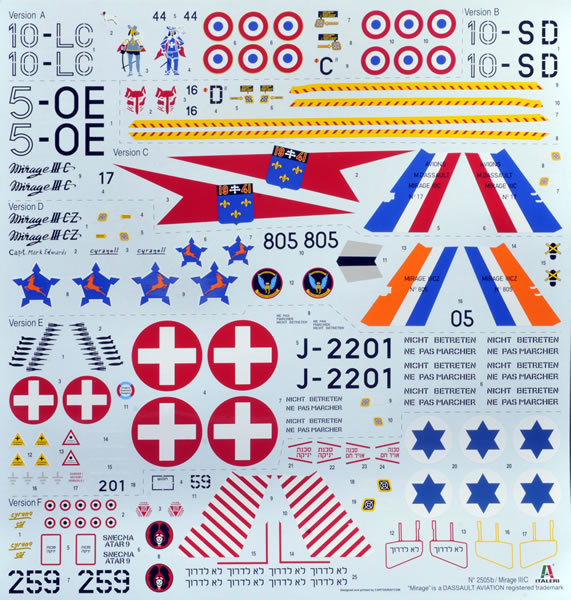
They have good saturation and are crisply printed.
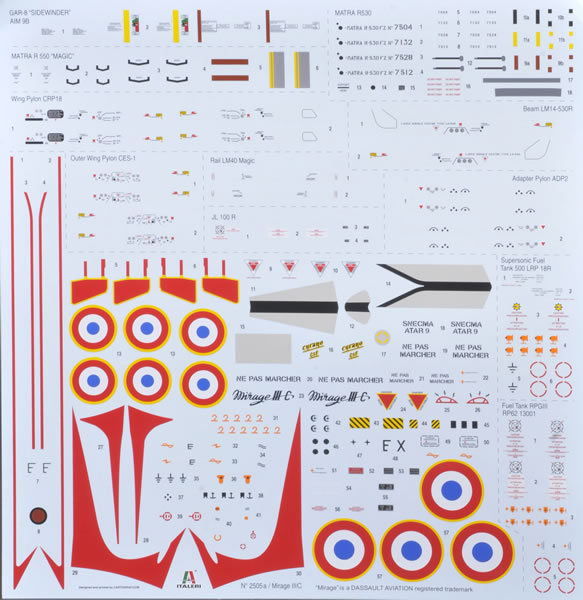
Italeri provides markings for six aircraft:
-
Mirage IIIC No 44 of Escadron de Chase 3/10 “Vexin” of the Armee de l Air in Djibouti in 1980. The aircraft is finished in Dark Earth, Middle Stone upper surfaces and light blue under surfaces
-
Mirage IIIC No 16 of Escadron de Chase 10/1 “Valois” of the Armee de l Air in Creil-Senils France in 1978. The aircraft is finished in Non Specular Blue/Grey upper surfaces and Aluminium under surfaces
-
Mirage IIIC No 17 of Escadron de Chase 2/5 “Ile de france” of the Armee de l Air in Orange Caritat France in 1967. The aircraft is finished in overall natural metal with the typical mirage red flashing around the intakes, electronic bay hatch and wing inboard leading edge.
-
Mirage IIIC/Z No 805 of 2 Squadron “Flying Cheetahs” of the South African Air Force at Waterkloof Air Base Pretoria in 1982. The aircraft is finished in Light Brown and Olive Drab upper surfaces and light gray under surfaces
-
Mirage IIIC No J-2201 0f the Swiss Air Force in 1962. The aircraft is finished in overall natural metal with the typical mirage red flashing around the intakes, electronic bay hatch and wing inboard leading edge.
-
Mirage IIICJ Shahak 59 of 101 Squadron of the Israeli Air Force based at Hatzor Air Base during the Six Day War 1967. The aircraft is finished in overall natural metal with the typical mirage red flashing around the intakes, electronic bay hatch and wing inboard leading edge and has 10 kills on the side of the forward fuselage..
This is a very nice kit and one that looks quite easy to build. The included colour schemes are very attractive and the final assembled kit should be very impressive. The kit most likely will need some nose weight to ensure that it will not be a tail sitter. All Mirage kits are marginal on centre of gravity and it would be best to add a little weight to the nose cone to be sure. Overall not much I can really criticise with this kit, you can build it straight from the box and end up with a highly detailed kit, except for the missing Defa gun barrels.
Thanks to The Hobby Company Limited for the sample.

Review Text Copyright © 2016 by Mick Evans
Review Images Copyright © 2016 by Brett Green
Page Created 31 May, 2016
Last updated
31 May, 2016
Back to HyperScale Main Page
Back to Reviews Page |
